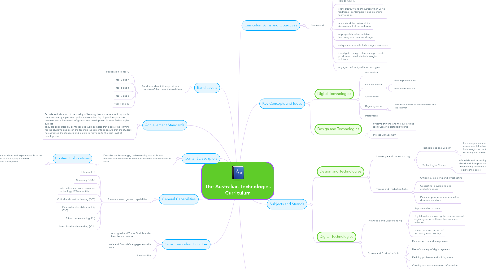
1. General Capabilities
1.1. There are seven general capabilities:
1.1.1. Literacy (LIT)
1.1.2. Numeracy (NUM)
1.1.3. Information and communication technology (ICT) capability
1.1.4. Critical and creative thinking (CCT)
1.1.5. Personal and social capability (PSC)
1.1.6. Ethical understanding (EU)
1.1.7. Intercultural understanding (ICU).
2. Cross Curriculum Priorities
2.1. Aboriginal and Torres Strait Islander histories and culture
2.2. Asia and Australia's engagement with Asia
2.3. Sustainability
3. Content Descriptors
3.1. Describe the knowledge, understanding and skills that teachers are expected to teach and students are expected to learn.
3.1.1. Content Elaborations
3.1.1.1. There are a support material to show and explain what is to be taught. They assist teachers in developing a shared understanding of the content descriptions.
4. Band Levels
4.1. Band level descriptions provide an overview of the content at each level.
4.1.1. Foundation to Year 2
4.1.2. Year 3 and 4
4.1.3. Year 5 and 6
4.1.4. Year 7 and 8
4.1.5. Year 9 and 10
5. Achievement Standards
5.1. Provide an indication of the quality of learning that students should typically demonstrate by a particular point in their schooling. It provides provides teachers with a framework of growth and development in each Technologies subject. They are supported by portfolios and work samples that display the learning for the students and assist the teachers judgements to ensure that the student has achieved the standard and is able to move on to the next level of development.
6. Curriculum Aims and Objectives
6.1. Students will:
6.1.1. develop their knowledge and understanding and skills
6.1.2. be provided with opportunities to work both independently and collaboratively.
6.1.3. show creativity and innovation when using traditional, contemporary and emerging technologies.
6.1.4. understand the history of the development of technologies.
6.1.5. appropriately select suitable technologies in creative design.
6.1.6. critique and evaluate technologies processes.
6.1.7. investigate, design, plan, manage, create, produce and evaluate technologies solutions.
6.1.8. engage confidently with technologies.
7. Subjects and Strands
7.1. Design and Technologies
7.1.1. Knowledge and Understanding
7.1.1.1. Technologies and Society
7.1.1.1.1. How people use and develop technologies taking into account social, economic, environmental, ethical, legal, aesthetic and functional factors and the impact of technologies on individuals, families, local, regional and global communities, the economy and the environment. (ACARA, 2013)
7.1.1.2. Technologies Context
7.1.1.2.1. -Materials and technologies specialisations. -Food and fibre production -Engineering principles and systems -Food technologies
7.1.2. Process and Production Skills
7.1.2.1. Critiquing, exploring and investigating
7.1.2.2. Generating, developing and evaluating ideas
7.1.2.3. Planning, producing and evaluating designed solutions
7.2. Digital Technologies
7.2.1. Knowledge and Understanding
7.2.1.1. Representation of data
7.2.1.2. Digital systems involving the components of digital systems: software, hardware and networks
7.2.1.3. Interactions and impact of technologies on society
7.2.2. Process and Production Skills
7.2.2.1. Data collection and interpretation
7.2.2.2. Use of a variety of digital systems
7.2.2.3. Defining problems and solving them
7.2.2.4. Creating and communication information
8. Student Diversity
8.1. ACARA is committed to the development of a high-quality curriculum for all Australian students that promotes excellence and equity in education. (ACARA, 2013)
8.1.1. Students with a disability
8.1.2. English as an additional language
8.1.3. Gifted and Talented students
9. Key Concepts and Ideas
9.1. Digital Technologies
9.1.1. Abstraction
9.1.2. Data collection
9.1.2.1. data representation
9.1.2.2. data interpretation
9.1.3. Specification
9.1.4. Digital systems
9.1.4.1. hardware, software and networks and the internet
9.1.5. Interactions
9.2. Design and Technologies
9.2.1. Systems thinking and the overarching idea: Creating preferred futures
9.2.2. Project Management
